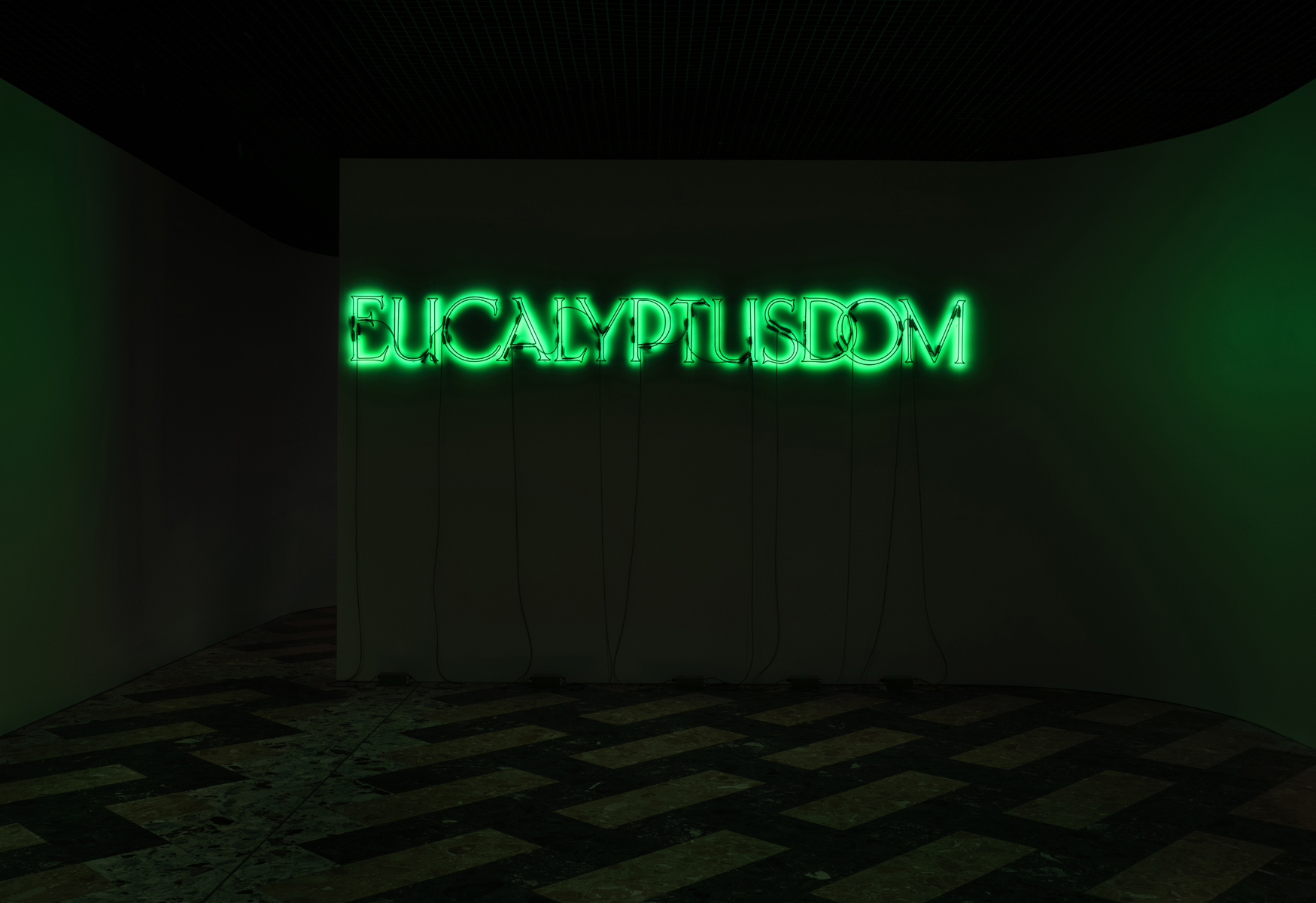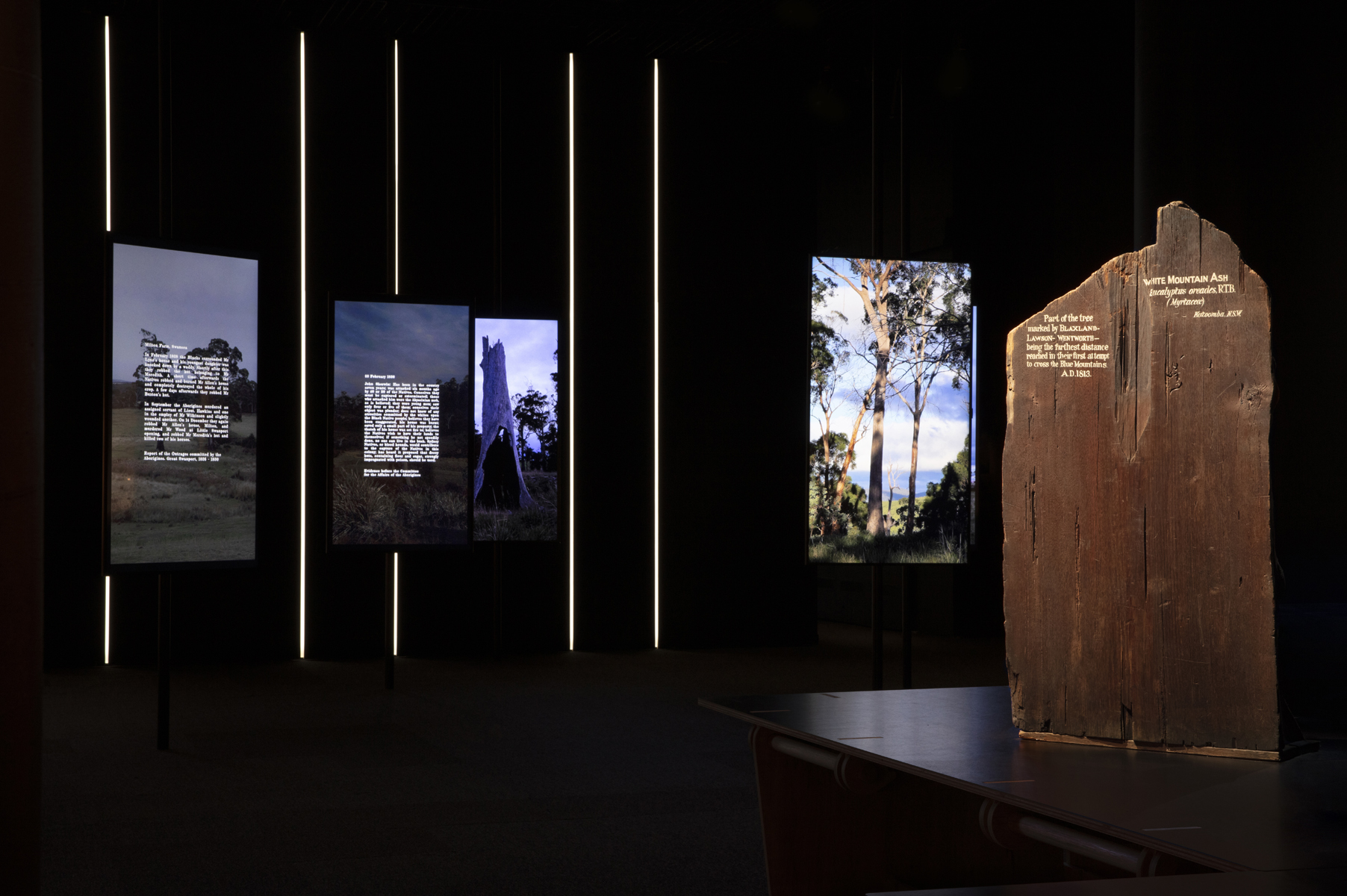Eucalyptusdom
Nick Croggon
If you’re in Sydney, you should see Eucalyptusdom, currently on view at the Powerhouse Museum. This is a show, however, that is not easily seen—-sparsely lit, and crowded with content, the show frustrates any easy visual understanding, instead asking viewers to hear, smell, and feel their way towards its meaning.
The Powerhouse Museum—-home to many a flashy science, technology or design show—-is no stranger to displays that prioritise immersive, sensory experience. Here, however, it expands its repertoire through the inclusion of a chorus of contemporary artists who seek to engage the viewer’s body and senses, and to place this experience within a conceptual, historical framework. The goal of the resulting show is to interrogate the history of the museum itself, and Australia’s settler colonial history more broadly.
Eucalyptusdom, then, should be read alongside other recent attempts by Sydney institutions to mobilise contemporary art and artists to reckon with their colonial pasts, and to break from them—-from Brook Andrew’s Sydney Biennale NIRIN in 2019, to the Australian Museum’s current Unsettled exhibition. As the Art Gallery of NSW opens a vast new space later this year, it should be on notice that the bar for such work has been set very high.
The Powerhouse occupies a key spot within Sydney’s broader network of exhibitionary institutions. Located (for now, at least) on a $343 million property at Ultimo, the Powerhouse (the major outpost of the Museum of Applied Arts and Sciences) is one of New South Wales’s big five state-funded cultural institutions, alongside the Opera House, the State Library, the Art Gallery of NSW and the Australian Museum. In 2019 to 2020, despite the global pandemic, it received over $37 million in government funding, and almost half a million visitors—according to its annual report.
Eucalyptusdom makes good use of the Powerhouse’s significant resources. Occupying almost the entire length of one of the museum’s industrial warehouses, the exhibition includes over 400 objects, which range across a handsome set of display tables specially designed by famed modernist architect Richard Leplastrier, with Adam Hadow and Worimi/Birippai architect Jack Gillmer. These darkly glowing surfaces match perfectly the exhibition’s soft lighting and elegant drapery, transforming the cavernous industrial shed into a close, almost cinematic space.
What is on view is, in essence, a collection show. Over five sections, the exhibition tells the story of the eucalyptus tree, and its special link to the Powerhouse Museum. The genus “eucalyptus” was first coined in the late eighteenth century by early colonial botanists and explorers in an attempt to classify and contain the unruly plurality of gum trees they found to grow natively across the Australian continent (today, around 900 different species). As Ashley Hay notes in her book Gum (Hay also authors the exhibition’s wall texts), from this point on the eucalypt became a key trope in the Australian story, a recurrent material and metaphor in the white settler imaginary.

By the late nineteenth century, when the exhibition’s narrative arc begins, the eucalypt was at the centre of the new colonial discipline of “economic botany”, which sought to transmute the tree from natural phenomenon to exploitable resource. The Powerhouse Museum, founded at this same moment, was an important engine of this discipline, providing a home to many a “eucalyptographer” (including its inaugural director, JH Maiden), and institutionalising its techniques of collection, testing and recording. The bulk of the exhibition’s objects are the material traces of this larger project—-an assemblage of botanic illustrations and photographs, meticulously labelled wood samples and test results, research records and correspondence.

Interleaved with these traces are seventeen new works by contemporary Australian artists, each of which engages directly with Australia’s eucalyptic history. The commissioned artists include seasoned interrogators of settler colonial history like Julie Gough (Trawlwoolway), Jonathan Jones (Wiradjuri/Kamilaroi) and Nick Mangan, alongside members of a newer generation like Yasmin Smith, Jazz Money (Wiradjuri) and Dean Cross (Worimi) . The powerful presence of Indigenous artists also signals a key structural change at the Museum: the appointment in May 2021 of Wiradjuri curator Emily McDaniel as its inaugural Director of First Nations.
While each of these commissions provides its own complex engagement with the exhibition’s materials, here I want to address the exhibition’s broader curatorial gambit, and consider how it inflects current debates about the colonial histories of Sydney’s exhibitionary institutions. In the extended acknowledgement of Country at the entrance to the show, which counts as its only real framing text, the Museum speaks directly to First Nations audiences. This exhibition, it advises, seeks to “reckon with the museum’s colonial collection practices” and, through a practice of “truth-telling”, aims to “shift the conversation of cultural institutions and our responsibility”.
This language responds directly to the call made by Aboriginal and Torres Strait Islander peoples in the Uluru Statement from the Heart. It also puts the exhibition into dialogue with the Australian Museum’s Unsettled exhibition, curated by Mariko Smith (Yuin) and Laura McBride (Wailwan/Kooma), which similarly sets out to re-tell—-with the aid of a suite of works by contemporary Indigenous artists—-the history of Australia’s creation, the land seizures and frontier wars, and the Indigenous sovereignty that has outlasted them. While the target of Unsettled’s truth-telling is Australia’s founding myths writ large (as embodied in the statue of James Cook that still stands just outside the Australian Museum’s doors), Eucalyptusdom confronts the peculiar history of its housing institution.
Founded in 1881, the Powerhouse can easily be understood as part of the nineteenth century tradition of the Euro-American “public museum” that also produced the Australian Museum and the Art Gallery of NSW. The Powerhouse, however, was established to be a new and more specific apparatus of display—-a “technological museum”. The goal of the technological museum, building on European models and the international exhibitions that spread through America and Australia in the mid-nineteenth century, was to celebrate industrial progress for a mass audience through a showcase of its most advanced technologies and commodities. Unlike the Art Gallery of NSW, this new museum was directed not to the colony’s cultural elite, but rather to its less educated working classes. As Tony Bennett has shown, this required a new museological strategy of “legibility”: the use of clear, well-signposted visual displays, easy-to-follow curatorial narratives, and hands-on learning. The goal of the technological museum was to craft a new colonial public, empowered to master their new land in rational, scientific terms.

One can see how the overlapping histories of the eucalypt and the technology museum contributed to the ongoing invasion of Australia. As Patrick Wolfe has explained, settler colonialism proceeds through a double logic of eradication, claiming territory by simultaneously eliminating its Indigenous inhabitants, and building a new colonial society. Eucalyptusdom shows us how economic botany aided this project by symbolically erasing Indigenous custodians from a landscape it recoded as resource, and by placing eucalypts within a narrative of industrial progress.
The exhibition’s canny title—-coined by the 1930s conservationist Edward F. Swain—-succinctly captures this double movement. The term “eucalyptusdom” gestures romantically to a lost natural wilderness, a wilderness that is retrospectively stripped of its Aboriginal custodians and instead reframed in imperial terms as a “kingdom” that, for the sake of progress, must be mastered.

The curatorial method that underpins Eucalyptusdom works to refute this history. In contrast to the legibility favoured by the nineteenth century technology museum, visitors to the exhibition are left to wander in the dark, baffled by eerie music (Jane Sheldon’s sound piece) and smells (Anna May Kirk’s eucalyptus oil scents). The exhibition’s display is jumbled and non-linear, its wall texts poetic and elliptical. In a presentation given in December 2021, curators Sarah Rees and Nina Earl explained that the Museum explicitly avoided the clarity of a single curatorial frame, instead adopting a collaborative process among the curatorial team (Rees, Earl, McDaniel, and artist Agatha Gothe-Snape), and the commissioned artists.
The show’s mode of truth-telling, then, is not the didacticism of the nineteenth century technology museum. Instead, as Earl noted, its multi-sensory approach seeks to “immerse” its audience in the social and environmental history it describes, providing space for the audience to make an “emotional connection” that could enliven within them a new personal political commitment. This mode of emotional connection is explicitly posed against a politics of display that favours “discord”, which Earl worries can unduly polarise and alienate.
The shift from a curatorial practice of presentation to one of sensory and emotional experience is, as Caroline Jones has detailed, a hallmark of global contemporary art—-a world that will soon envelop Sydney in the next Biennale, and into which the Powerhouse Museum is making deliberate steps. The risk of this reliance on “experience” and “emotional connection”—-especially when opposed to a politics of “discord”—-is that it smooths over the discord that underscores the reality of life in Australia today, from ongoing practices of invasion to environmental crisis, giving us the emotional and sensorial stamina to tolerate them. Are we being trained to live with Captain Cook statues, just as we now live with COVID-19?
Ultimately, however, Eucalyptusdom provides no such haven for good feelings. The exhibition title and texts, and its selection of collection objects, ooze a melancholic yearning by Australia’s white settlers for the eucalypt and its unruly capaciousness, even as they pursue its rationalisation, mastery and erasure. This contradictory impulse—-which the exhibition tracks from the early eucalyptographers, to conservationists, to May Gibbs’ beloved Snugglepot and Cuddlepie—-appears here as a key emotive partner to the rationality that usually defines the Enlightenment project.
(It was the Sydney artist Agatha Gothe-Snape who first pointed this out to me, and it makes sense that she was one of the instigating forces for this exhibition, in her role as an embedded artist at the Powerhouse. Gothe-Snape has long taken feeling, and its instrumentalisation by language, architecture and bureaucracy, as a central material in her practice, and her new role at the Powerhouse is an exciting and logical extension of this.)

The exhibition also, however, frames a different set of feelings. While Vera Hong’s gorgeous film of a Blue Mountains eucalypt forest suggests the un-peopled wilderness described above, the trees in Trawlwoolway artist Julie Gough’s work, positioned directly adjacent, mark the sites where the massacre of Lutruwita’s (Tasmania) Aboriginal people took place. The work envelops the viewer in a historical experience of loss and mourning—-and yet the trees’ presence also radiates an ancient and enduring strength. In a nearby work, Wiradjuri artist and poet Jazz Money evokes the love and care that lives in Country, suggesting that Australia’s eucalpytic history has not extinguished this knowledge, but has rather disseminated it around the world. Throughout the exhibition one detects the work of Yindyamarra, a Wiradjuri way of going slowly and with care that McDaniel explicitly adopts in her curatorial work.
The immersive complexity of Eucalyptusdom, then, moves towards two different ends. On the one hand, it frames a settler colonial sentiment of love and loss, one that has been passed down the line of Australian history via the trope of the eucalypt. On the other, it invites us to know an alternative matrix of feelings that exist outside and against the colonial project—-feelings of deep sadness and care, and the experience of Indigenous beauty, protest and enduring sovereignty in the face of invasion that Money has elsewhere called “radical joy”.
The exhibition’s framing of these feelings for its viewers, not as triggers for an easy sensorial or emotional spectacle, but as profoundly historical and political objects, is the kind of thick experience that the best of our contemporary cultures of display can achieve.
Nick Croggon is an art historian, writer and editor based on Gadigal and Wangal land. He is Events and Programs Officer at the Power Institute, and is completing a PhD at Columbia University, New York.


